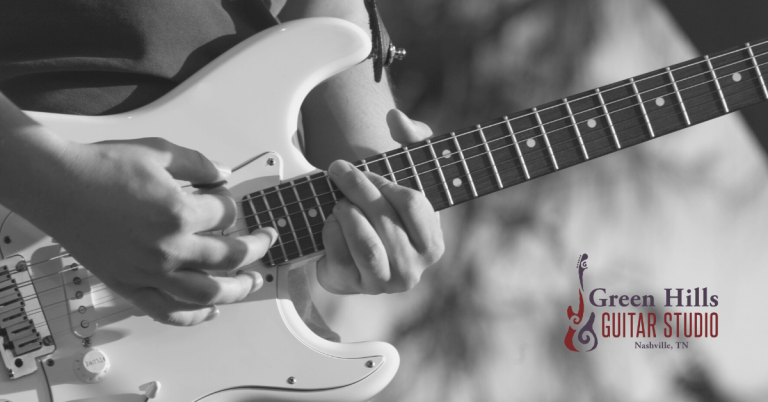Understanding the CAGED System for Guitar
The CAGED System is a powerful tool for guitarists to expand their understanding of the fretboard and develop their skills in composition and improvisation. By understanding its components and exploring its applications, guitarists can unlock the potential within their instrument. This article will discuss the basics of the CAGED System and how to use it.
What is the CAGED system?
The CAGED system is a method for connecting the fretboard by leveraging common open chord shapes. These chord shapes are C, A, G, E, and D. These five major chord shapes can be connected in this specific order up and down the neck of the guitar. Thus its name—the CAGED system.
Benefits of Learning the CAGED System
Understanding the CAGED System can benefit guitar players of all levels. For beginner guitarists, the CAGED System can help them understand the fretboard better and learn how to play chords and progressions more easily. It can also give them a framework to develop more advanced skills like improvisation and soloing.
For more experienced guitarists, the CAGED System can help them to break out of the same old patterns they have been playing and become more creative. It can also help them to understand how different scales and keys work together and how to transition between them.
The CAGED System provides guitarists with a comprehensive system for understanding the fretboard and unlocking their potential as a musician.
Chords vs. Chord Shapes
One area of confusion with the CAGED system may stem from the need for more distinction between an actual chord (C major, for example) and a chord shape (a C major chord “shaped played at the 4th position, which produces an E major chord). You might be saying, “Uh … what?.” Don’t worry—it’s not that bad.
If you’ve ever used a capo, you know that you can move 1st position (“open” position) chords to a different location on the neck. Just slap the ol’ capo on the neck at some point (let’s say 4th fret), and play the tired old C major chord you always play, and boom! Instant key change.
Remember that while the capo’d chord looks like a C major and feels like a C major, it is certainly not a C major. Why not? Well, it can’t be. Because it moves to a different location of the guitar, it now contains a different set of notes. It is a C “shaped” chord, sure, but in the 4th position, it is an E major chord (it contains the notes E, G#, B, E, G#)
CAGED is the same concept but without the capo. That’s right — you must be able to play barre chords. One of your fingers takes on the role of the capo. If you’ve not taken the first steps to develop a barre technique, prioritize it.
Common Practice
You may ask, “Well, can’t I pretend it’s a C major chord?” That would make life easier. While it’s true that we can refer to the name of the chord relative to the capo (C major) rather than what the chord is (E major), be careful with this approach — other instruments don’t typically use capos. If you tell a piano player the first chord is C major and play a C “shaped” chord at the 4th position, you’ll surely garner angry glances from your fellow musicians.
Learning the chord shapes up and down the neck without the aid of the capo ensures that you must learn what you are playing and can make music with eh CAGED system. This takes time and effort. If you aspire to true musicianship and creative freedom, you must absolve yourself from the tyranny of the capo! You’ll need a solid barre technique and a basic understanding of all the guitar neck notes.
Exploring the CAGED System
Exploring the CAGED System is a great way for guitarists to better understand the instrument and how its notes and chords are positioned on the fretboard. The CAGED system is an acronym for the five major chords in the key of C: C, A, G, E, and D. Each of these chords is associated with a major scale and a minor scale, allowing players to move seamlessly between chord shapes.
Working with these chord shapes helps budding guitarists learn the different positions of the guitar fretboard. Basic chord shapes are established chords rooted on the sixth string and shifted up and down the neck to create different chords. Moveable chord shapes refer to chords rooted on the fifth string and are moved up and down the fretboard to create different chords.
How to Use the CAGED System to Create Solos
The CAGED system can be used in various ways, including in solos. Players can use the five major chords associated with the CAGED system to create solos. By understanding the major scale, a guitarist can use the notes from the scale and play a solo that follows the song’s chord progression.
Common Chord Progressions to Practice
To practice using the CAGED system, guitarists can use several familiar chord progressions. For example, a C Major chord can be followed by an A minor chord and then a G Major chord. This progression can be repeated and shifted up and down the fretboard. Additionally, a G Major chord can be followed by an E minor chord and then a D Major chord.
Understanding the CAGED system is an excellent way for guitarists to master the fretboard, develop their soloing skills, and write their own songs. By understanding the major scales, chords, and chord progressions associated with the system, guitarists can create solos and play songs with more confidence.
Should I Learn the CAGED System?
You may be thinking, “This sounds difficult. Is it worth learning?” The answer is no.
Well, you should learn it, but it wouldn’t be the first system I’d recommend due to the knowledge gaps it creates and the limitations it imposes on the player. When teaching guitar, I prioritize other learning systems ahead of the CAGED system.
A triadic approach is preferable. Or learning a scale system, arpeggios, chord inversions, or chord families. Or even learning the same note across all six strings below the 12th fret. Or simple voice-leading concepts. Or mapping out octaves and intervals in a position. You get the picture.
What are the Disadvantages of Learning the CAGED System?
One of the main disadvantages of the CAGED system is that it can be restrictive. Learning and understanding can be challenging and require much practice and dedication. Additionally, it can be difficult to transition from one chord shape to another, especially if you are unfamiliar with the various chord shapes. For beginners, keeping up with all the different shapes can be overwhelming and demanding.
Other guitar learning approaches exist if the CAGED system seems too complicated and overwhelming. Focusing on basics like chords, scales, and strumming patterns and learning songs in different genres can help you develop a strong foundation.
Learning different fingerpicking techniques can also help you become more familiar with the instrument. Taking lessons from a knowledgeable instructor can also help improve your skills and understanding of the guitar.
The Takeaway
The CAGED system is an excellent supplement to a solid foundational understanding of the fretboard. It should be incorporated at some point in the guitar player’s journey, but certainly not at the beginning.
If you’d like more information about the CAGED system or other fretboard systems that are more useful, effective, and easier to learn, please get in touch with Green Hills Guitar Studios today to schedule your private lesson.







